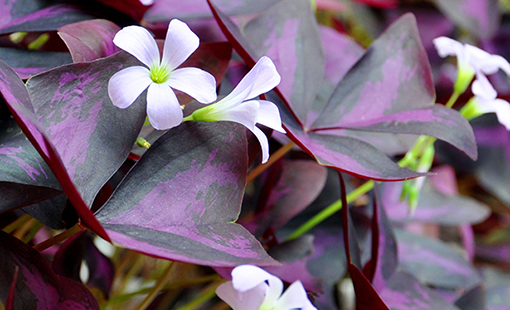
Oxalis Care & Info
Oxalis, also known as the shamrock plant, is the largest genus in the family Oxalidaceae and represents about 800 of the 900 species within the family. It is a large genus of flowering plants with over 550 species native to the tropical climates of South America and South Asia. Often referred to as Wood Sorrels, Oxalis are also known as False Shamrocks and a plethora of other common names. Of the Oxalis species in cultivation, Oxalis triangularis is the one most commonly cultivated as a houseplant.
Oxalis are not only excellent houseplants because they come in a range of colors and sizes, but also because they are so prolific. They are, in fact, SO prolific that they are considered to be weeds to gardeners and greenhouse growers worldwide. Many will go through a dormant phase in the wintertime if kept as a houseplant. A significant portion of the plant may die and go into dormancy if not receiving enough light. Give a dose of fertilizer and more light and it’ll grow back.
Many oxalis, like most legumes and a few other plants, exhibit a phenomenon known as nyctinasty. Nyctinasty is a form of rhythmic circadian nastic movement of plants in response to the onset of darkness. The plant senses light quality and type via receptors, and sends a response to the pulvini, which are joints bulging with cells at the base of the leaflets. The pulvini then release sugars and potassium ions that eventually cause the characteristic drooping of the leaflets.
Sunlight
Thrives in bright indirect to bright direct light. Not suited for low light conditions.
Water
Water every 1-2 weeks, allowing soil to dry out halfway down between waterings. Expect to water more often in brighter light and less often in lower light.
Humidity
Any humidity level will do. Normal room humidity is fine.
Temperature
Oxalis does best when the temperature is between 65 F – 85 F, and shouldn’t go below 60 F.
Pests & Diseases
It is generally a very easygoing plant. Should it get spider mites, treat the plant as soon as they appear with weekly sprays of horticultural (Neem) oil and regular wipe-downs of the plant.
SYMPTOM: Yellow leaves, mushy stems
CAUSE: Overwatered, root rot
SYMPTOM: Wilting brown leaves, crispy edges
CAUSE: Underwatered, low humidity
SYMPTOM: No new growth
CAUSE: If the plant goes dormant, lightly fertilize and provide bright light and water
Is it Toxic?
Irritating to cats, dogs and humans if consumed. Best practice is always to keep houseplants out of reach of small children and pets.
Information courtesy of TheSill.com

 Adams Fairacre Farms
Adams Fairacre Farms